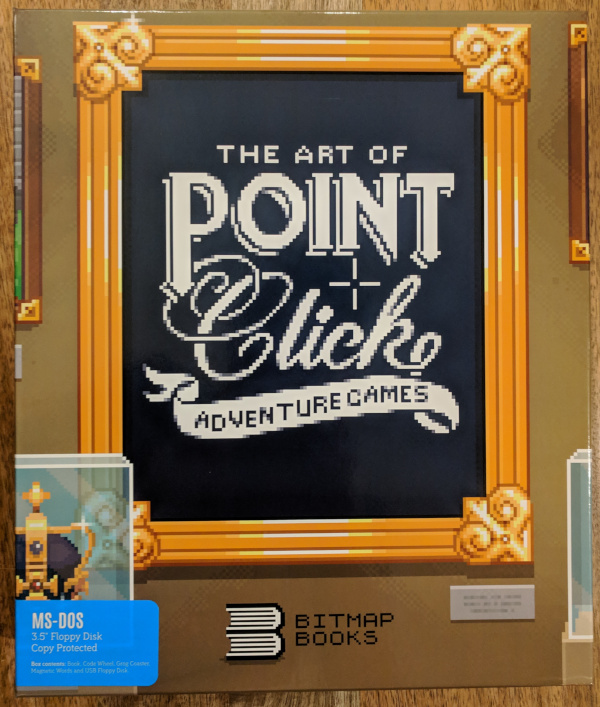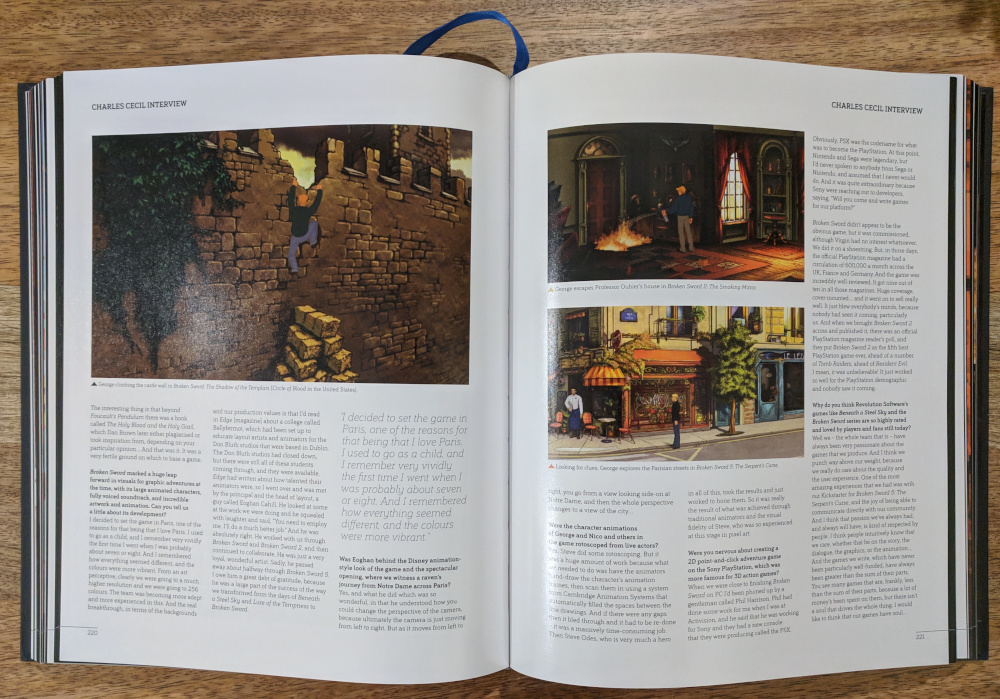The Art of Point-and-Click Adventure Games
Reviews
Please sign in or register to add your own review.
Like many nerds of my generation, I grew up playing games like Maniac Mansion, Zak McKracken, Monkey Island and (I’ll admit it) Leisure Suit Larry. These point and click adventure games offered immersive stories, atmospheric graphics and music, challenging (and often maddeningly unfair) puzzles, a lot of humor, and memorable characters—from Stan the used boat salesman to Larry Laffer and his laughable attempts to get laid.
I’m also a big fan of art books—paging through gorgeous photographs or paintings on the couch is just so much more relaxing than staring at a screen. So, when I read that Bitmap Books was making an art book about point and click adventures, I had to pre-order a copy. I couldn’t resist getting the (limited) collector’s edition, which arrived a few months later in a package like a classic PC game:

Art of Point and Click Adventures Collector’s Edition (Credit: Bitmap Books. Fair use.)
Just like old-school games, in addition to the book itself, the box contained several “feelies”:
-
a USB flash drive embedded in a fake miniature floppy disk, containing a PDF of the book, some game demos, and some wallpapers;
-
a “Dial-an-Interview” wheel styled after Monkey Island’s “Dial-a-Pirate” copy protection;
-
a sheet of refrigerator magnets for constructing your own silly adventure game sentences (“Give ID card to rat”);
-
a bunch of game art postcards;
-
a “Tri-Island Brewery” grog coaster (yet another Monkey Island reference).
The book without the feelies, which is all you can buy from Bitmap Books at this point, is still an elegant product, with a silver foil blocked cover and a convenient bookmark ribbon. It features art from the 1980s to today, alongside interviews with the humans behind the games: people like Al Lowe (Leisure Suit Larry), Ron Gilbert (Monkey Island), Brian Moriarty (Loom), Charles Cecil (Broken Sword), Tim Schafer (Day of the Tentacle), David Fox (Zak McKracken), and Noah Falstein (Indiana Jones)—to name just a few. Instead of photographs, many of the interviewees get their own pixel art avatars in the book.

Interview with Charles Cecil alongside some art from the Broken Sword series. (Credit: Bitmap Books. Fair use.)
The game art itself is reproduced in different sizes—some screens are blown up to the size of two full pages, which, well, let’s just say that there’s a reason they call it pixel art. In addition to screenshots from the games, the book includes sketches, character art, and backgrounds (some background scenes are multiple screens wide). There is a bit of repetition, but much of it is purposeful—showing how the same scene was created in 16 vs. 256 colors, for example.
The text could have used a bit more editing here and there, and the interviews often go over the same ground (“What was it like working at LucasArts?”) again and again with different interview subjects. But they do include many interesting tidbits about the artistic process and the personal and professional stories of the genre’s luminaries before and since the games we know them for.
The book is organized chronologically, and it does give some space to recent entrants, from Thimbleweed Park (review) to The Lion’s Song (review). If you think point-and-click adventures are dead, you couldn’t be more wrong—touch devices have brought classic adventure games to millions of new fans; crowdfunding and marketplaces like Steam and Gog help sustain a thriving community of independent game makers.
All in all, if you’re like me in at least two ways—you love the genre, and you appreciate beautifully made physical books—I highly recommend getting a copy of The Art of Point-and-Click Adventure Games, or putting it on your wishlist. This is not a book to turn to for critique; it is unadulterated joy and nostalgia. Beyond that, it’s inspired me to try out a few games I didn’t know about before.
Thanks to projects like ScummVM, commercial re-releases, and abandonware archives, games that were copied on floppies by teenagers decades ago are still eminently playable today. Thanks to publishers like Bitmap Books, they are getting the historical recognition they deserve, not just as entertainment, but also as an art form.
About
-
Online stores Amazon Databases Wikidata Review sites Goodreads - عمل مكتوب ar
-
Show uploaded media
Uploaded media:
boxadventure-1543297415919.jpg
Art of Point and Click Adventures Collector's EditionCredit: Bitmap Books. Fair use.Source: own photographpointandclickart-1543299043435.jpg
Interview with Charles Cecil alongside some art from the Broken Sword series.Credit: Bitmap Books. Fair use.Source: own photographSource data licensing:
Data from Wikidata is available under Creative Commons CC-0.
lib.reviews is only a small part of a larger free culture movement. We are deeply grateful to all who contribute to this movement.